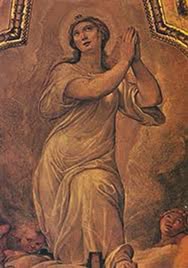August Saints
Saint Cajetan of Thiena (1480-1547)
Saint Cajetan was a noble of Vicenza, where he was born in 1480. He renounced his wealth and ecclesiastical dignitiesto devote himself to the poor and the suffering of his native town, and afterwards to the welfare of the pastoral office at large by founding in 1524 the first congregation of Clerks Regular, called Theatines.
A distinguished student, went to Rome, joined the Congregation of Divine Love and introduced frequent Communion in their midst. He was also instrumental in the introduction the Forty Hours’ Adoration of the Blessed Sacrament.
To renew the lives of the clergy, in 1524, Cajetan founded the first group of Regular Clerics, the Theatines. Worn out with toil and sickness, he died in 1547.
Saint Cajetan, obtain for us a great love of the Blessed Eucharist.
(Source: www.magnificat.ca/cal/engl/08-07.htm)
Saint Edith Stein (1891-1942)
Edith Stein was born in Breslau in 1891, the youngest of eleven children. Her father died when she was only two, leaving her mother to look after the family and the business. While still a child, Edith lost her faith in God. “I consciously decided, of my own volition, to give up praying,” she said.
Having passed her school-leaving exam with flying colours, she enrolled at the Universities of Breslau and Göttingen to study German and history, though her real interest was in philosophy and in women’ issues. There she met the philosopher Max Scheler, who directed her attention to Catholicism. Her university career was spectacular, but she was refused a professorship because she was a Jew.
Having converted to Catholicism, and met up with Christian people, writing articles on philosophy, reading the New Testament and the Spiritual Exercises of St Ignatius helped her on her way. Finally, she read the autobiography of St Teresa of Avila. She had found the truth she was seeking. “When I had finished the book, I said to myself: ‘this is the truth’.” Later, looking back on her life, she wrote: “My longing for truth was a single prayer”.
Baptised in 1922, Edith was acutely conscious of her belonging to Christ, not only spiritually but by her Jewish blood. “I had given up practicing my Jewish religion when I was a 14-year-old,” she said, “and did not begin to feel Jewish again until I had returned to God.” For twelve years, she engaged in teaching, writing and studying, successfully combining scholarship and faith in her work and teaching, seeking to be a tool of the Lord in everything she taught.
During the First World War, having done a nursing course, she serve in an Austrian field hospital. Not long after, she went to Frankfurt Cathedral one day and saw a woman with a shopping basket going in to kneel for a brief prayer. “This was something totally new to me,” she wrote. “Here I saw someone coming straight from the busy marketplace into this empty church, as if she was going to have an intimate conversation. It was something I never forgot.”
She entered Carmel, became known as Sister Teresa Benedicta of the Cross and took her final vows in 1938. “I understood the cross as the destiny of God’s people,” she wrote, “which was beginning to be apparent at the time. I felt that those who understood the Cross of Christ should take it upon themselves on everybody’s behalf. Of course, I know better now what it means to be wedded to the Lord in the sign of the cross. However, one can never comprehend it, because it is a mystery.”
On 9 November 1938 the anti-Semitism of the Nazis became apparent to the world. Sister Teresa was arrested by the Gestapo on 2 August 1942 while she was in chapel with her Sisters. After transit camp, Edith was deported to Auschwitz, where she, along with hundreds of other Jews, was gassed.
Saint Edith, give us the courage of our convictions, even to death.
(Source: www.vatican.va/news_services/liturgy/saints/...)
Saint Susanna (†286)
Saint Susanna is believed to have been nobly born in Rome. Reputedly the niece of Pope Saint Caius, she made a private vow of virginity. The Emperor Diocletian, on her refusal to marry a suitor recommended by him, had Susanna beaten in her residence, then decapitated secretly.The emperor’s wife, Prisca, who was also a Christian in secret, buried her body clandestinely and prayed to her as a holy martyr. Later the house of Gabinius was transformed by Pope Saint Caius into a church. Saint Susanna suffered towards the beginning of Diocletian’s reign, about the year 286.
Saint Susanna, obtain for us the grace to suffer willingly for our faith.
(Source: www.magnificat.ca/cal/engl/08-11.htm#susanna)

 Entries(RSS)
Entries(RSS)